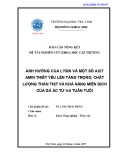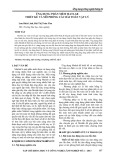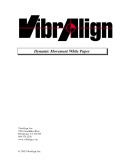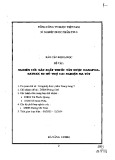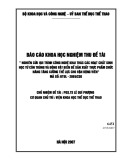
Luquita et al. Journal of Biomedical Science 2010, 17:8
http://www.jbiomedsci.com/content/17/1/8
The cost of publication in Journal of Biomedical Science
is bourne by the National Science Council, Taiwan.
Open Access
RESEARCH
© 2010 Luquita et al; licensee BioMed Central Ltd. This is an Open Access article distributed under the terms of the Creative Commons
Attribution License (http://creativecommons.org/licenses/by/2.0), which permits unrestricted use, distribution, and reproduction in
any medium, provided the original work is properly cited.
Research
In vitro
and
ex vivo
effect of hyaluronic acid on
erythrocyte flow properties
A Luquita*
1
, L Urli
1
, MJ Svetaz
2
, AM Gennaro
3
, ME Giorgetti
1
, G Pistone
1
, R Volpintesta
4
, S Palatnik
4
and M Rasia
1
Abstract
Background: Hyaluronic acid (HA) is present in many tissues; its presence in serum may be related to certain
inflammatory conditions, tissue damage, sepsis, liver malfunction and some malignancies. In the present work, our
goal was to investigate the significance of hyaluronic acid effect on erythrocyte flow properties. Therefore we
performed in vitro experiments incubating red blood cells (RBCs) with several HA concentrations. Afterwards, in order
to corroborate the pathophysiological significance of the results obtained, we replicated the in vitro experiment with ex
vivo RBCs from diagnosed rheumatoid arthritis (RA) patients, a serum HA-increasing pathology.
Methods: Erythrocyte deformability (by filtration through nucleopore membranes) and erythrocyte aggregability (EA)
were tested on blood from healthy donors additioned with purified HA. EA was measured by transmitted light and
analyzed with a mathematical model yielding two parameters, the aggregation rate and the size of the aggregates.
Conformational changes of cytoskeleton proteins were estimated by electron paramagnetic resonance spectroscopy
(EPR).
Results: In vitro, erythrocytes treated with HA showed increased rigidity index (RI) and reduced aggregability, situation
strongly related to the rigidization of the membrane cytoskeleton triggered by HA, as shown by EPR results. Also, a
significant correlation (r: 0.77, p < 0.00001) was found between RI and serum HA in RA patients.
Conclusions: Our results lead us to postulate the hypothesis that HA interacts with the erythrocyte surface leading to
modifications in erythrocyte rheological and flow properties, both ex vivo and in vitro.
Background
Elevated seric hyaluronic acid (HA) is a feature of certain
inflammatory conditions, notably rheumatoid arthritis and
scleroderma, and also accompanies tissue damage, sepsis,
liver malfunction and some malignancies [1-8].
Additionally, the employment of HA is currently sug-
gested in the therapy of arthritis, arthrosis, psoriasis, and it
is also included in treatments with cosmetic products [9-
12].
Being HA a macromolecule present in plasma, it could
interact with the red blood cell (RBC) surface, as it happens
with albumin. In a previous work [13] we have demon-
strated that albumin adsorption impairs erythrocyte rheol-
ogy in a concentration-dependent fashion increasing the
erythrocyte rigidity index (RI). Such facts lead us to
hypothesize that the reduction in erythrocyte deformability
(RI increase) observed in serum HA-increasing pathologies,
could be due to HA interaction with RBC surface which
contributes to the impaired flow properties observed in
these pathologies [14,15].
We therefore conducted this study to investigate the sig-
nificance of serum HA effect on erythrocyte flow proper-
ties.
We performed in vitro experiments incubating RBCs
from healthy donors with several HA concentrations. After-
wards, in order to corroborate the obtained results, we
selected a serum HA-increasing pathology and replicated
the experiment ex vivo with RBCs from those patients. We
chose rheumatoid arthritis RA patients because in an earlier
paper we demonstrated a reduction in erythrocyte RI that is
in close correlation with the Disease Activity Score (DAS
28-4) index during the clinical remission of the process
[16].
* Correspondence: luquitale@hotmail.com
1 Cátedra de Física Biológica, Facultad de Ciencias Médicas, Universidad
Nacional de Rosario, Santa Fe 3100, 2000 Rosario, Argentina





